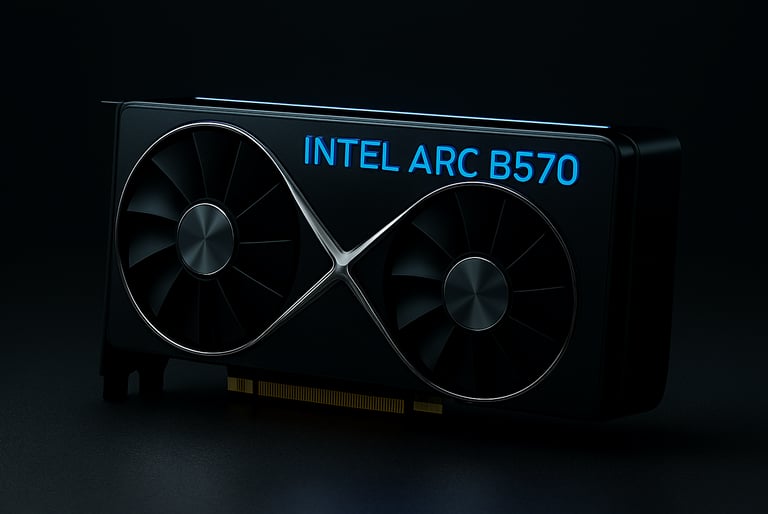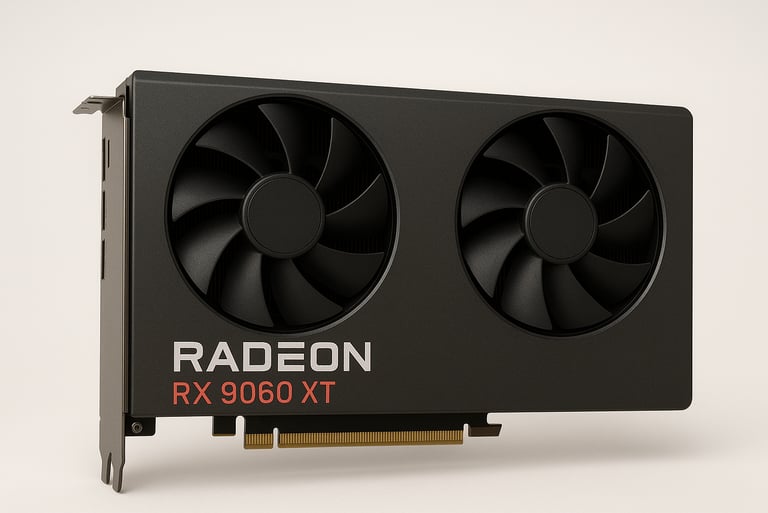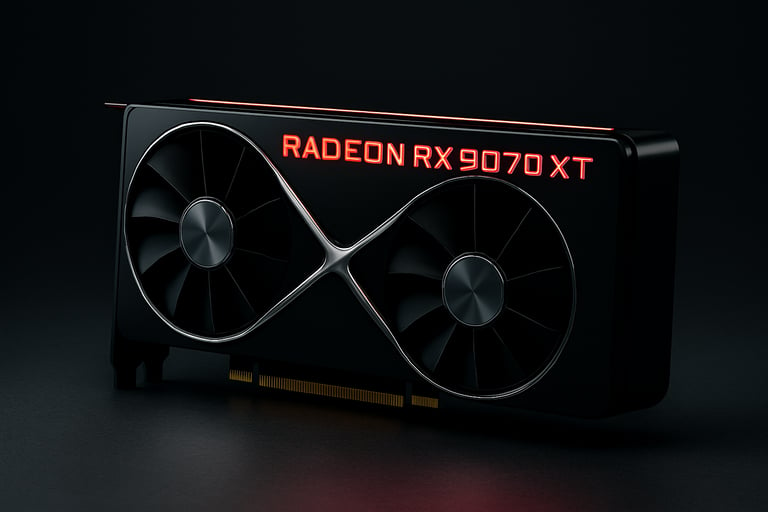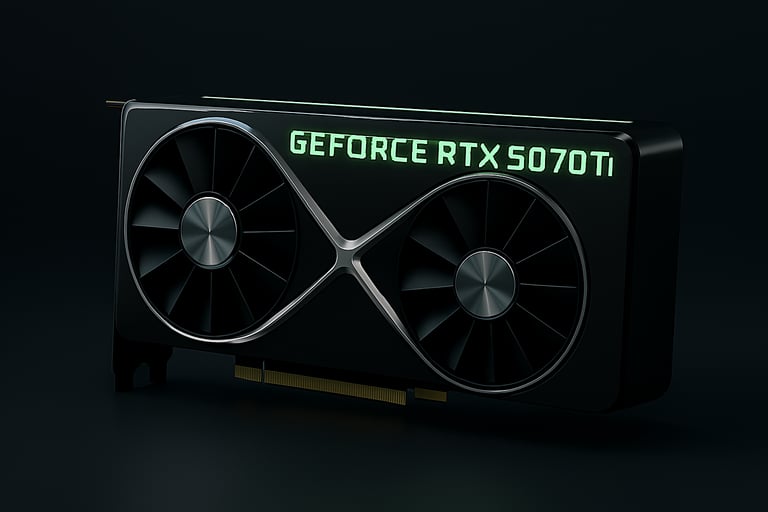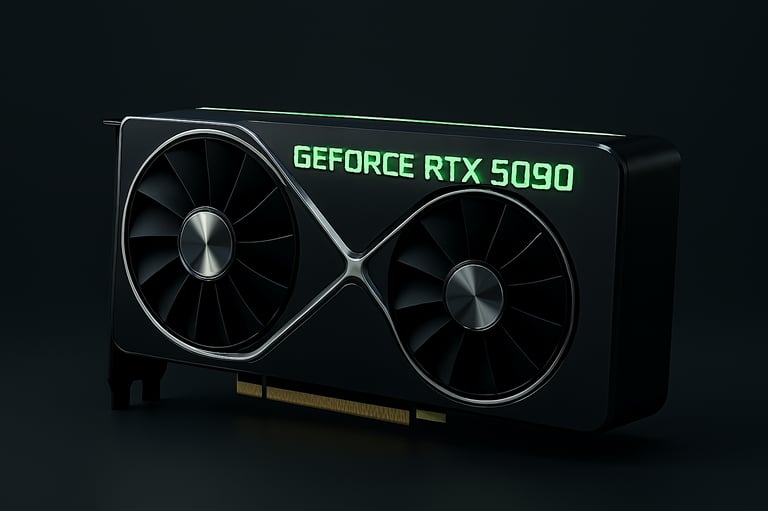Best Gaming GPUs of 2025 – Top 5 for Power & Performance
Explore the top 5 gaming GPUs of 2025, including RTX 5090, RX 9070 XT, and Arc B570. Compare specs, performance, and find the best graphics card for your setup.
10/16/202513 min read
The Top 5 Best PC GPUs in 2025: Performance, Value, and Power for Every Desktop Gamer
When you purchase through links on our site, we may earn an affiliate commission. Learn More
By Epic Loot Links Updated last Oct 16, 2025 at 12:59 pm
Intro: The State of the Desktop GPU Market in 2025
The landscape of desktop PC GPUs in 2025 is the most competitive and technologically advanced it has ever been. Major players—NVIDIA, AMD, and Intel—have all released powerful next-generation graphics cards tailored for a wide spectrum of purposes, from high-end 4K gaming to energy-efficient builds and budget-conscious rigs. Technological leaps in architecture, VRAM, upscaling methods, and AI acceleration have pushed performance boundaries and redefined what gamers and creators can expect for their investment. As GPU demand stabilizes after years of turbulence and supply chain disruptions, consumers find more options at or near MSRP, making 2025 arguably the best year yet for building or upgrading a desktop gaming PC.
But with innovation comes complexity. The choice isn’t just about raw horsepower—efficiency, feature set (DLSS 4, FSR4, XeSS, ray tracing, AI acceleration), thermal performance, and price-to-performance ratios are critical factors for both gamers and professionals. In this report, we present the top 5 best PC GPUs of 2025, each analyzed in depth for its performance, value, efficiency, and suitability for modern workloads. NVIDIA’s Blackwell architecture, AMD’s RDNA 4, and Intel’s refined Battlemage Xe2 core are all represented, revealing a market that rewards careful shoppers with the best PC GPUs across every price band.
Whether you’re chasing the absolute highest frame rates in 4K, looking for smart spending at 1440p, or building on a budget but refusing to sacrifice modern features, this guide brings together real-world benchmarks, technical specifications, and the latest expert reviews. If you have questions about what gaming monitor or what gaming cpu to choose from, visit our blogs.
1. NVIDIA GeForce RTX 5090: The Ultimate 4K/8K GPU in 2025
Amazon.ca
The NVIDIA GeForce RTX 5090 stands at the absolute summit of desktop GPU performance in 2025—delivering unrivaled 4K and 8K gaming, AI, and creative production capabilities. Built on the advanced Blackwell architecture, the 5090 boasts staggering hardware specifications: 32GB of GDDR7 memory on a 512-bit bus (offering 1,792 GB/s bandwidth), 21,760 CUDA cores, PCIe 5.0 support, and a jaw-dropping 575W TDP. This card is designed not merely to break records but to future-proof even the most demanding PC builds for years ahead.
In real-world testing with titles such as Cyberpunk 2077: Phantom Liberty, Dragon’s Dogma 2, and God of War Ragnarök, the RTX 5090 consistently delivers 20–50% higher frame rates than the previous RTX 4090—reaching 100–120+ FPS at 4K Ultra settings with ray tracing and DLSS 4 Multi Frame Generation (MFG) enabled. Synthetic benchmarks (3DMark Time Spy ~47,500) and AI workloads further underline the card’s dominance.
DLSS 4 with MFG is transformative—generating up to three AI-driven frames for every hardware-rendered one, producing super-smooth gameplay even at ultra-high resolutions. The RTX 5090 is also the gold standard for creators and AI professionals, combining three hardware encoding engines, superior ray tracing, and unmatched memory bandwidth.
Key Specifications (RTX 5090)
GPU cores / Architecture: 21,760 CUDA (GB202, Blackwell)
VRAM: 32GB GDDR7, 1,792GB/s bandwidth
Boost Clock: 2,407–2,700MHz (varies by board)
Bus Width: 512-bit
Power Draw (TDP): 575W (requires 1,000W PSU recommended)
AI/Compute: DLSS 4 with Multi-Frame Gen, three encoder engines
Release Date / MSRP: Jan 2025 $1,999+
3DMark Time Spy: ~47,500
Pros
Unparalleled performance for 4K/8K gaming and content creation; 30–50% faster than RTX 4090.
32GB GDDR7: Future-proofs for large textures, AI, and professional workloads.
DLSS 4 + Multi-Frame Generation: Game-changing visual smoothness and performance boosts.
Excellent for AI research and 3D rendering; industry-best acceleration on creative tasks.
Efficient cooler designs keep thermals manageable for such high TDP.
Cons
Extremely expensive: MSRP is $1,999–$2,500+, and street prices can be higher.
Massive power requirements: Needs a 1,000W+ quality PSU; high peak draw.
Physically large: 3- to 3.5-slot designs may not fit all cases.
Value diminishes for anything below 4K; often bottlenecked at 1080p/1440p.
Not necessary for most gamers unless paired with top-tier CPU and display.
Analysis
There is simply no close competitor at the high end: The RTX 5090 sets a new standard for flagship PC graphics. If your workflow or gaming hobby absolutely demands the fastest rendering, maximal future headroom, or advanced AI features, there’s no better choice. However, for all but the most demanding users, the price-to-performance sweet spot is likely found lower in NVIDIA or AMD’s 2025 lineup. Given the thermals, power, and cost, the 5090 is a true halo product—an indulgence for those who refuse to compromise on any front.
2. NVIDIA GeForce RTX 5070 Ti: 1440p and Enthusiast 4K Sweet Spot
Amazon.ca
NVIDIA’s GeForce RTX 5070 Ti is the premier choice for enthusiast gamers aiming for high-refresh 1440p, premium 4K experiences, or efficient content creation without the obscene costs or power draw of flagship cards. Designed around the Blackwell GB203 core, it brings 16GB of GDDR7 memory on a 256-bit bus, 8,960 CUDA cores, and a 300W TDP, striking an appealing balance of cutting-edge features and well-calibrated performance.
The 5070 Ti supports NVIDIA’s DLSS 4 with Multi-Frame Generation, PCIe 5.0, and improved tensor/AI operations, making it a complete, forward-looking package. Benchmarks reveal performance roughly equivalent to the previous RTX 4080 or just below the new 5080, but at a significantly lower price—typically 10–20% ahead of last year’s 4070 Ti Super and standing toe-to-toe with AMD’s best. At 1440p Ultra, most games exceed 100 FPS, while playable 4K gaming (especially with DLSS 4) is within reach.
Key Specifications (RTX 5070 Ti)
GPU Cores / Architecture: 8,960 CUDA (GB203, Blackwell)
VRAM: 16GB GDDR7, 896GB/s bandwidth
Boost Clock: ~2,452 MHz
Bus Width: 256-bit
TDP: 300W (3x 8-pin or 12VHPWR)
AI/Compute: DLSS 4 & MFG
Release Date / MSRP: Feb 2025 $749
3DMark Time Spy: ~27,600
Pros
Excellent performance for 1440p high-refresh and 4K with upscaling.
DLSS 4 and AI features close the gap with more expensive models.
16GB VRAM offers plenty of headroom for future games/textures.
Power efficient and cooler than previous generation flagship cards.
PCIe 5.0 and DisplayPort 2.1 for next-gen monitor compatibility.
Cons
Smaller generational leap over 4070 Ti Super than some expect.
Still expensive: True value depends on finding at/near MSRP.
16-pin power connector and teething issues with new cables persist.
AMD’s 9070 XT offers similar raw performance for less, but lacks DLSS and some proprietary features.
Analysis
The RTX 5070 Ti strikes the center of the high-end market: it provides nearly all the features of the RTX 5090 for less than half the price, and remains unmatched for those who want high-FPS 1440p without entering “halo product” territory. If you prioritize maximum frame rates and image quality at 1440p/4K, want superior DLSS 4, and aren’t deterred by the ~$750 price tag, this is one of the best all-around choices for enthusiasts in 2025. Its balance of performance, cooling, and forward-looking features make it the most versatile NVIDIA GPU for demanding gamers and creators.
3. AMD Radeon RX 9070 XT: The Enthusiast’s Value Leader in 2025
Amazon.ca
The AMD Radeon RX 9070 XT is widely celebrated as the most well-rounded enthusiast GPU for value-driven gamers and creators. Its core strengths lie in high raster performance, significant architectural improvements in ray tracing and AI (via RDNA 4), and competitive pricing. With 16GB of speedy GDDR6, 4,096 shaders, a 256-bit bus, and a ~304W TDP, the RX 9070 XT closes the gap nearly everywhere with NVIDIA’s best, especially after AMD’s advancements in ray tracing pipeline and AI frame generation.
Benchmarks show the RX 9070 XT trading blows with the RTX 5070 Ti; it matches or exceeds NVIDIA in rasterized workloads, leads in standard 1440p/4K gaming, and sits within 5% of the 5070 Ti in most real-world tests—but at $599 MSRP (or lower on sale). AMD’s FSR4 is now competitive with DLSS in image quality on many titles, and 16GB VRAM ensures future-proofing where modern games demand high memory usage. However, while ray tracing performance is much improved (sometimes 40–50% over RDNA 3), NVIDIA’s DLSS 4 and specialty RT performance still lead the field.
Key Specifications (RX 9070 XT)
GPU Cores / Architecture: 4,096 shaders (Navi 48, RDNA 4)
VRAM: 16GB GDDR6, 640 GB/s bandwidth
Boost Clock: 2,970 MHz
Bus Width: 256-bit
TDP: 304W
FSR4: Advanced upscaling + frame generation
Release Date / MSRP: Mar 2025 $599
3DMark Time Spy: ~30,445
Pros
Outstanding value; delivers near flagship performance for ~40% less.
16GB VRAM keeps it future-ready for high-res textures and new titles.
FSR4 upscaling closes quality/performance gap with NVIDIA DLSS 4.
Efficiency gains (especially at 1440p/4K) over prior AMD generations.
Significant improvement in ray tracing and AI vs. last generation.
Cons
Still behind NVIDIA for advanced RT features, software, and AI frameworks.
FSR4 game support not as broad as DLSS 4 (but improving).
Hefty 304W power draw, similar to NVIDIA’s high-end cards.
$599 MSRP rarely matches street prices (expect small premium).
Analysis
AMD’s RX 9070 XT is the value king for enthusiasts in 2025. If ray tracing isn’t your main focus, or if you prefer open ecosystems (FSR4, better Linux support), it’s the best price/performance pick for high-end gaming—and a popular alternative for professionals wanting lots of memory and horsepower on a budget. With 1440p/4K performance rivaling NVIDIA’s $750 cards, but at lower real-world prices, it’s a standout recommendation for anyone seeking top-tier speed without the NVIDIA tax.
4. AMD Radeon RX 9060 XT 16GB: The Mainstream and Efficiency Marvel ( personal favorite)
Amazon.ca
Positioned as the best mainstream and efficiency-focused graphics card of 2025, the AMD Radeon RX 9060 XT 16GB brings superb value to the desktop GPU market. It is aimed directly at 1080p/1440p gamers who want to game at ultra settings without paying premium prices—or sacrificing VRAM for future titles. Built on the RDNA 4 Navi 44 core, the card features 16GB of GDDR6 memory, a narrow 128-bit bus, 2,048 shaders, and a low 160W TDP, meaning systems can be built smaller, quieter, and less expensive.
Performance data reveals the RX 9060 XT outperforming NVIDIA’s RTX 5060/5060 Ti (especially 8GB variants) at every resolution except 4K, where its limited bandwidth is felt. At 1080p/1440p Ultra, 16GB VRAM is a major advantage—not only for gaming, but also for creative, video, and AI workloads. Ray tracing is available (as are FSR4 and frame generation), though NVIDIA still leads in advanced RT scenarios. The MSRP—$349 at launch—is rarely matched due to high demand, but real-world prices sit under $400.
Key Specifications (RX 9060 XT 16GB)
GPU Cores / Architecture: 2,048 shaders (Navi 44, RDNA 4)
VRAM: 16GB GDDR6, 320 GB/s bandwidth
Boost Clock: 3,130 MHz
Bus Width: 128-bit
TDP: 160W
FSR 4 / Frame Generation: Yes
Release Date / MSRP: Jun 2025 $349
3DMark Time Spy: ~16,494
Pros
Huge VRAM (16GB) at a mainstream price: future-proofs for years.
Superb efficiency and cooling; average gaming loads pull just 160W.
Excellent for 1080p and strong for 1440p gaming at ultra settings.
Silent or near-silent operation; ideal for compact/quiet builds.
Competitive in creative and professional apps (AI, video, 3D) thanks to memory capacity.
Cons
Not ideal for demanding 4K or heavy ray tracing workloads.
Raw memory bandwidth trails NVIDIA’s GDDR7 cards.
AMD’s FSR/AI software still slightly behind NVIDIA’s mature platform.
Limited overclocking and performance headroom.
Analysis
The RX 9060 XT 16GB hits the mainstream GPU sweet spot in 2025—offering nearly everything most gamers need (and more) for under $400. For those who don't care about maximum ray tracing or 240Hz 4K FPS, it's a no-compromise card that will keep up with AAA games for years. Its massive VRAM, silent efficiency, and budget-friendly pricing also make it the best choice for small form factor systems, family PCs, or anyone needing memory-heavy productivity at a mainstream cost.
5. Intel Arc B570: The 2025 Budget and Casual Gaming Champion
Amazon.ca
Intel’s Arc B570 is the dark horse of 2025, delivering significant value and modern features to gamers on a tight budget. Based on Intel’s second-generation Battlemage Xe2 architecture, the B570 offers 10GB of GDDR6 memory, 2,304 Xe cores, and a very mild 150W TDP. Launched at a $219 MSRP, it competes fiercely with AMD and NVIDIA’s entry-level cards by beating 8GB models with its larger VRAM buffer and credible performance at both 1080p and 1440p.
In real-world gaming, the B570 averages 60+ FPS at 1080p Ultra and ~45-60 FPS at 1440p Medium-High in the latest demanding titles (e.g., Cyberpunk 2077, Final Fantasy XIV, Baldur’s Gate 3). The inclusion of 10GB VRAM means even new AAA games with higher memory requirements won’t choke this budget card, setting it apart in an era of 8GB stragglers. Intel’s XeSS 2 upscaling tech also rivals FSR and DLSS for select titles, letting users trade image quality for better performance when needed. It also brings AI hardware, ray tracing, and modern encoding to truly entry-level builds.
Key Specifications (Arc B570)
GPU Cores / Architecture: 2,304 Xe cores (BMG-G21, Xe2)
VRAM: 10GB GDDR6, 380 GB/s bandwidth
Boost Clock: 2,750 MHz
Bus Width: 160-bit
TDP: 150W
XeSS 2 / AI Features: Yes
Release Date / MSRP: Jan 2025 $219
3DMark Time Spy: ~12,600
Pros
Best VRAM on a budget: 10GB memory ensures smoother, future-proofed gaming at 1080p.
Strong 1080p and credible 1440p performance for under $250.
Modern feature set: Ray tracing, AI upscaling (XeSS 2), PCIe 5.0, and efficient cooling.
Runs cool and quiet, with compact, modest power requirements (no need to upgrade PSU).
Cons
Not suitable for demanding ray tracing or high-res 4K gaming.
Driver maturity still trailing NVIDIA/AMD; can suffer rare compatibility issues.
Inconsistent performance on older CPUs—must pair with modern platforms.
**Better “bang for buck” may exist in last-gen used cards or Intel’s own B580 for $30 more.
Analysis
The Arc B570 targets a specific—but still massive—market: those building gaming PCs in the $500–$800 range, students, secondary/family PCs, or users needing “good enough” 1080p performance for upcoming game releases. It brings all the essentials and modern software stack to low-cost PCs, refusing to cut corners on VRAM and feature set.
A note of caution: to realize its full performance, pair with a modern CPU (Ryzen 5000/Intel 12th gen or newer) and keep drivers up-to-date for best results. For the money, though, there’s genuinely nothing else like it in new, warrantied cards in 2025.
Deep Dive: Key Gaming, AI, and Productivity Metrics
Rasterization and Ray Tracing Performance
RTX 5090: The undisputed leader, achieving up to 195 FPS in Cyberpunk 2077 at 4K Ultra, 133 FPS in Dragon’s Dogma 2, and 108 FPS in Starfield. Ray tracing benchmarks show 30–50% uplifts over the 4090 with DLSS 4/MFG pushing game performance past 200 FPS at 4K in select titles.
RTX 5070 Ti: Over 60+ FPS at 4K Ultra in most AAA games, over 120 FPS at 1440p Ultra, and nearly 200 FPS in esports or competitive titles. Similar performance to a 4080 with improved efficiency and modern feature set.
RX 9070 XT: Matches 5070 Ti in raster at 1440p and 4K, at a lower price; performance advantage narrows or reverses in favor of NVIDIA in ray tracing-heavy games. On average: 119–130 FPS at 1080p Ultra, 98–110 at 1440p Ultra, up to 61 FPS at 4K Ultra before FSR is used for upscaling.
RX 9060 XT 16GB: Offers 80–100 FPS at 1080p Ultra, 60+ FPS at 1440p Ultra, ~30 at 4K Ultra. Ray tracing playable at 1080p, but best suited for raster gaming or with FSR upscaling.
Arc B570: Hits 60+ FPS at 1080p High in most games; outperforms RTX 4060 and RX 7600 in several titles at launch. 1440p gaming viable at medium/high with the help of XeSS—Ray tracing support available and improved over previous gen, but not a main selling point.
Power Efficiency and Thermals
RTX 5090: 575W TDP; world-class thermal/cooling designs with 2-3 slot options, stays quiet and under 80°C in most environments. Requires robust PSU and case airflow.
RTX 5070 Ti: 300W TDP; notably cooler and more power efficient than last-gen 4080, with premium quiet coolers and premium build, typically under 70°C.
RX 9070 XT: 304W TDP; comparable to 5070 Ti, with efficient power use aided by new N4P node. Runs cool even under load but requires a decent PSU.
RX 9060 XT 16GB: 160W TDP (often 190–220W in custom cards); typically silent and cool, even at full load; ideal for small builds.
Arc B570: 150W maxed; stays under 70°C with dual/axial fan designs. Idle power and compatibility are improved, but PSU and CPU choice remain important to stability.
AI and Professional Workloads
RTX 5090: The AI/Pro/Viz king—massive acceleration on Stable Diffusion, Blender, and 8K/12K video tasks, thanks to enlarged tensor and RT cores, DLSS 4, and huge memory pool.
RTX 5070 Ti / RX 9070 XT: Both are excellent for 4K video editing, 3D rendering, and advanced AI workloads, though NVIDIA maintains leadership in software support and some proprietary tools.
RX 9060 XT 16GB: Punches well above typical mainstream cards in productivity, especially where VRAM is a bottleneck.
Arc B570: Perfectly serviceable for most casual content creation and some AI, hampered only by memory size in extreme cases. XeSS 2 can speed up rendering, encoding.
How to Choose the Best Desktop GPU in 2025
The range of desktop graphics cards in 2025 means that there is genuinely a perfect fit for almost any use case and budget. Here’s what to consider for your next upgrade:
Resolution and Refresh Rate: If you’re on a 1080p/144Hz panel, the RX 9060 XT 16GB or Arc B570 are perfect; 1440p/165Hz is best served by the RTX 5070 Ti or RX 9070 XT; 4K/240Hz demands an RTX 5090 or nothing at all.
VRAM For Future-Proofing: 8GB is no longer enough; even 12GB is bare minimum, with 16GB or more strongly advised if you expect AAA releases or large-scale content creation.
Ray Tracing/Upscaling: Prefer NVIDIA for games using RT and upscaling (DLSS 4), but AMD’s FSR4 is a close match in supported games. Intel’s XeSS 2 is a bonus at the entry-level.
Efficiency: Smaller builds or power-saving PCs should look to AMD’s RDNA 4 (RX 9060 XT 16GB) or Intel’s Arc B570 for their combination of silent running and low power needs.
Price-to-Performance: If you want best “bang for buck”, RX 9070 XT and RX 9060 XT 16GB are best buys at $500 and below; the 5070 Ti and 5090 are about features/halo performance, not economy.
Creative/AI Use: RTX 5090 is indisputably the leader, with RX 9070 XT and RTX 5070 Ti as strong secondary options for video, AI, and 3D.
Closing Thoughts: The Best PC GPUs of 2025 for Gamers, Creators, and Everyone In Between
2025 sees the PC GPU market more mature, capable, and consumer-friendly than ever. NVIDIA remains the brand for power users, highest frame rates, and proprietary feature seekers with its Blackwell-based RTX 5090 and 5070 Ti. Meanwhile, AMD’s Radeon RX 9070 XT and 9060 XT 16GB deliver the best value across high-end and mainstream segments, giving peace of mind to those who want maximum VRAM and performance-per-dollar ratios without being locked into a closed ecosystem. Intel, with the Arc B570, finally delivers an option for budget-sensitive gamers who refuse to accept outdated technology or meager RAM raising the standard for entry-level cards and future-proofing even the most affordable new PCs.
Comprehensive benchmarking and user feedback indicate that there’s genuinely no bad choice here just a “best” fit for your performance, efficiency, and value needs. Let your monitor, workload, and budget guide your selection armed with this report, you’ll make a GPU choice in 2025 that pays off for years to come.
Remember: The best GPU is only as good as the rest of your system-pair your graphics card with an adequate CPU, PSU, and cooling to get the most out of your investment.


